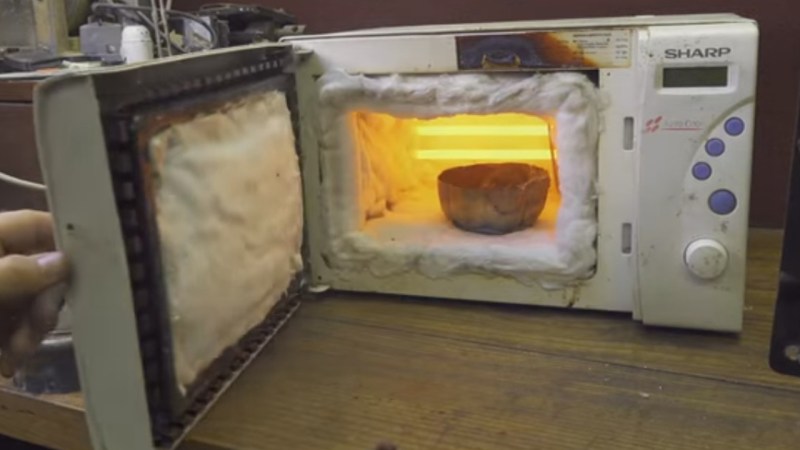Microwave ovens are a treasure trove of useful parts: transformers, an HV capacitor, a piezo speaker, and a high torque motor, to name just a few. In a new twist, [Rulof Maker] strips all that out and uses just the metal case to make a furnace for melting aluminum, copper and bronze.
His heat source is a quartet of 110 volt, 450 watt quartz heating elements which he mounts inside in the back. To reduce heat loss, he lines the walls with ceramic fiber insulation. Unfortunately, that includes covering the inside of the window, so there’s no pressing your nose against the glass while you watch the aluminum pieces turn to liquid. If you’re going to try making one of these yourself then you may want to consider adding a fuse.
It does the job though. In around nine minutes he melts enough scrap aluminum in a stainless steel bowl to pour into a mold for a test piece. But don’t take our word for it, see for yourself in the video below.
If want more information on what useful parts are inside then check out this primer. Or you can leave the parts in and use the oven as is for melting lead, but keep a fire extinguisher handy.















Wow, neat novel project and video. Never thought about using those elements and I have some from a 29 cents Goodwill Store toaster oven I’m going to use as a reflow oven. When I first saw this I was thinking some custom wound HV arc or RF furnace system. Also, makes me think about using an old top or front loader washer/dryer with a metal door for a furnace or more-so kiln frame…. maybe with another smaller inner frame to have a space for air to flow.
I’ve had the exact same idea, but wasn’t sure if the elements would survive the types of temperatures that are needed for aluminum. I guess this settles that question though. At least for the short term.
You can make (or buy small) microwave susceptors that will let you melt metal in a functioning microwave oven. It’s common in some art / jewelry circles for melting small amounts of silver and gold(maybe?). Basically the same principle as your hot pocket crisper sleeve but with more insulation to protect the microwave case.
Iron oxides work to a point but silicon carbide works for higher temps. You can even melt glass, it becomes it’s own susceptor once you get it a dull red with a rose bud or other heat source.
https://hackaday.com/2005/01/24/microwave-oven-foundry/ laid out the general ideas, but the link no longer exists (and wowie has the comment section on hackaday improved since then.)
http://www.instructables.com/id/microwave-smelter/ is a more modern instructables on using SiC to do this. It should work even better with a SiC crucible. They aren’t particularly expensive.
The comments here have gone through cycles, from civil to barbaric and back again. It happens every few years.
We’re trying to swing back to civil ATM. Thanks for noticing. :)
You just need to mix perlite with high temperature cement and then shape the mix into a round base plate, then make as large a dome shape as will fit on top of the base and still be able to rotate. Paint the inside of the dome with a susceptor, I think graphite sugar and magnetite powder mixed into a past with water will do. The sugar burns off and leaves a matrix that holds that layer in place, it may even form silicon carbide in reaction with the perlite at high temperature.
Wow! Just a few weeks ago, I snagged a microwave in a curb surf. I THOUGHT all I was interested in was the transformer, and the case has just been sitting around taking up space until I could haul it to a recycling center. But as it happens, I have a roll of ceramic fiber insulation and a hotplate element I was going to use to build a foundry, but haven’t gotten around to the build, for lack of a clear idea how to make a housing for the whole rig. Well, there’s my answer!
I love how he marks the holes without measuring, and then drills next to the marks. All the time stressing that it’s important to do this accurately.
Yeah this person’s videos have that lots; talking about “accuracy” and “precision” and then, I dunno, bending sheet metal with a hammer. I haven’t been able to figure out whether that’s a gag, or what.
That’s a big drawer for Viagra
The sign “Viagra per Nani” means “Viagra for Dwarfs”
One thumb up for ingenuity, on thumb down for PPE (or rather lack of it).
This should have been entitled “Using a microwave oven as a box”. I am still trying to figure out why use a microwave for this purpose instead of a container that is built to withstand heat. There are lots of plans out there for DIY refractory furnaces that I think would work much better.
I’ve been checking out diy furnaces lately and it seems like the outer box can be anything steel, incl old buckets, kitchen ovens etc. The microwave concurrently comes with a door and hinges already made
Conveniently comes with a door*
If you try this you might look for “ceramic rigidizer” on Amazon or Ebay. Used to coat the ceramic fiber so it won’t produce small fibers that float around in the air.